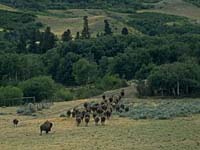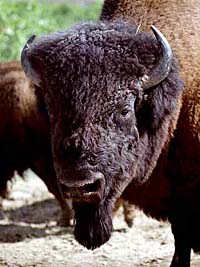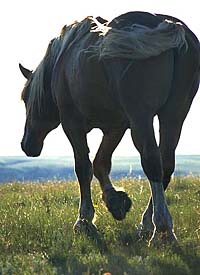|
|

|

|

|
Some historians and archaeologists believe that human history
in Saskatchewan began 30,000 or 40,000 years ago. By hunting and following herds of animals, they crossed the Bering land bridge that once connected Asia to Alaska. The people spread southward through an ice-free corridor just east of the Rocky Mountains, between the cordilleran and continental glaciers.
Research indicates that there have been several migrations of people, the last one 5,000 or 6,000 years ago during which, archaeologists suggest, the Inuit and Athabaskan Indians came to North America. The Indian peoples believe that they have always lived here. Regardless of how people came to live in North America, people farmed here prior to the time of European settlement.
|

Bison were critical to the life of the early inhabitants of the Great Plains. Bisons provided people with food, skins for clothing and shelter, containers, tools, weapons, and fuel. People were nomadic, moving their belongings with dog-pulled travois in order to stay near the wandering herds. Early hunters ambushed bison at water holes, trapped them in gullies, or hunters surrounded. Later, bison were stampeded over cliffs (buffalo jumps) or trapped in corrals (buffalo pounds). Horses and rifles changed the hunt, allowing a single skillful hunter to kill many animals for his family and tribe. |

For more than 11,000 years, Indians lived and thrived in Saskatchewan, hunting buffalo and other animals, and gathering wild plants for food. Evidence of their activities, found at many sites throughout the Province, give us insights into their life. |
Stone tools provided clues about the activities and time periods. Like changes in our technologies such as automobiles, stone projectile points show clear patterns of change that archaeologists can trace over time. Changes in the size and shape of the points also reflect developments in hunting technology, as spears gave way to smaller, longer range darts used with spear throwers (atlatls), which were later abandoned in favour of the more efficient bow and arrow.
Plains Indians used domesticated dogs to transport goods long before horses were available. Harnessed to a travois - a carrying platform strung between two poles - a dog (or horse) could drag a considerable load over the uneven prairie.
Large, circular stone arrangements of stones known as medicine wheels, dot the Plains landscape, often on high and beautiful places. These mysterious remnants of the past are an important part of Indian spirituality.
Before the horse, few non-agricultural tribes (Blackfoot, Comanche and Kiowa) lived on the Great Plains. Other tribes also recognized the advantages of bison hunting with horses; some (Cheyenne, Crow and Sioux) abandoned their semi-sedentary agricultural lives for hunting nomadism, while others (Shoshoni, Nez Perce and Cree) were lured onto the plains by the ease and excitement of the bison hunt or the pressures from European settlement in the east. The Great Plains became an era of turmoil and change. Successive groups attained power through access to large supplies of horses and guns, or through strong alliances. The era became a melting pot for about thirty different peoples and, within 50-100 years, many of their former cultural differences had disappeared. |

Changes were to come from the white man's world. With the horse came individualism, for there was less need for communal hunting; and status, for a horse was a sign of wealth. Trade goods such as guns, cookware and blankets created a sense of desire and ownership. The Europeans brought diseases, like smallpox, that nearly destroyed many tribes.
|
|
|
|
|
